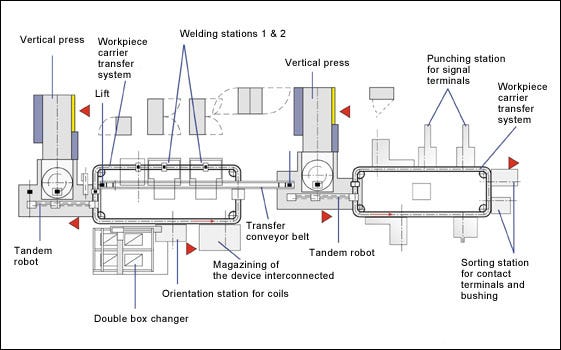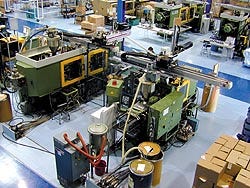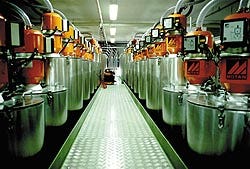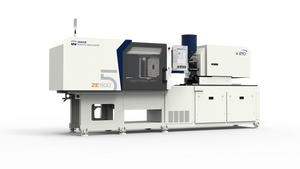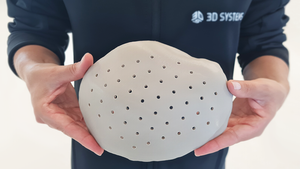May 23, 2001
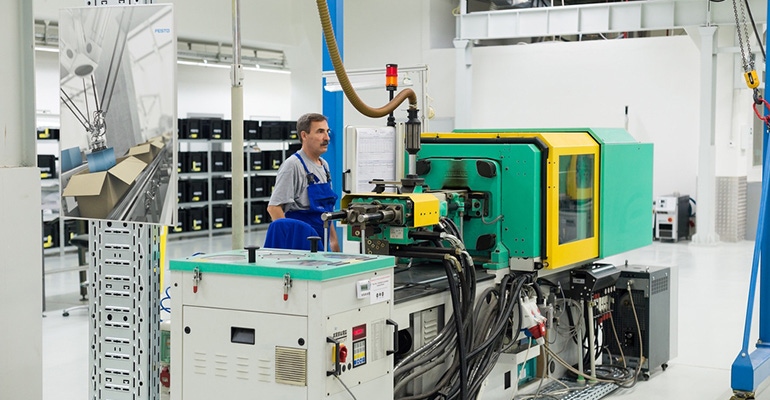
The following is an edited excerpt from The Business of Injection Molding, by Clare Goldsberry. The book is the first title in the IMM Book Club Injection Molding Management Series, published by IMM. While much of the focus in the book is on a custom injection molding operation, many of the points about plant layout, machinery and equipment required, and staffing apply to captive molding operations as well.
Two decades ago, a $30 million custom molding company was considered a top business. Today, as a result of mergers, acquisitions, and growth that has outpaced the national average, a company that size is considered small. So although an individual can set up a small injection molding operation for less than $1 million, unless the company has a special capability to offer or establishes a sound financial relationship with one or two customers, chances for success are slight.
In addition, entering custom injection molding with two or three presses and minimal capabilities means entering a highly competitive market already crowded at the low end with several thousand molders. Because many of these molders, with sales less than $1 million annually, offer little in the way of secondary services, they compete on the basis of price. This results in thin margins and a low survival rate.
When the demand for world-class molding facilities is added to state-of-the-art manufacturing capabilities, the bar for entry into the custom injection molding business rises considerably. Instead of being able to enter the molding business on a shoestring, as many did 30 years ago, a large financial investment is now required. This generally requires the cooperation of a bank, an equipment leasing or lending institution, and financial backing from private investors to pull together the funds needed to succeed. Likewise, the barriers to entry for a captive operation to provide a good return on investment are high. It's not enough to buy molding machines and auxiliaries and leave them in place without improvements for the long haul. Captive operations also must not only make an initial investment, but also be prepared to stay technologically attuned.
|
To be successful, many leading molders are installing complete molding cells to mold parts, assemble and decorate them, and then pack the completed product for delivery. The cell shown at left is for a valve gear housing and incorporates many secondary operations. It represents the setup challenges that molders face today. |
Find a Niche and a Focus
Most custom molders in business today have found a niche. Through experience, the molder became good at molding a particular type of part or at molding a particular kind of material, or became astute in working in a specific segment of the marketplace. In other words, he acquired an expertise and stuck with it. A captive molder inherits a market or a range of products, but must develop the same expertise and focus that a custom molder does.
Today it's increasingly apparent that if you're starting a plant or a business, you are either given or must find a niche—a specific market or product line—and focus on molding for that market or customer. Will you mold large parts? Small parts? Do you want to be a molder of low-volume, high-dollar parts? Or high-volume, low-dollar parts? Most people would answer that they want to be a molder of high-volume, high-dollar parts. If only it worked that way.
For example, disposable medical components such as injection syringes are manufactured and used in the millions daily. However, the return from each one of these devices is in the tenths of a cent. Quality and manufacturing requirements are extremely stringent, and the parts generally are made from clear or clear-tinted material, which compounds the difficulty of molding. In order to make a profit, molders who choose this type of high-volume medical work must find ways to keep manufacturing costs at a minimum and efficiency high.
| Molders with high-volume medical work must find ways to keep manufacturing costs at a minimum and efficiency high. |
Some molders prefer lower-volume parts molded for high-dollar products, which tend to offer better profit margins. For example, the box that houses the instrumentation monitoring an IV drip must meet tough cosmetic standards, and it's only produced in quantities of 100,000 a year. Others prefer to mold component parts such as gears that remain out of sight, which means that although fit and function still are critical, cosmetic requirements are less stringent.
Finally, it's usually not enough to just mold parts anymore, package them in a box, and send them to the customer, traditionally called "shoot and ship." Many manufacturers go to molders now looking for design and engineering services, tooling assistance, and postmold decoration and assembly expertise. Captive molders, as well, are more likely to have several secondary functions integrated with the molding of the basic parts.
All these factors add up in determining where and what kind of plant needs to be built.
Plant Layout
Assuming you have the capital to support a startup, or have a budget from corporate headquarters, you start physical construction with the plant. Whether you build or buy, the layout of your plant is a crucial consideration if you're going to have an efficient, profitable operation. Allow approximately 1000 sq ft of space for each molding press; this accounts for offices, molding/production, secondary operations, quality control, storage of materials, and a mold maintenance and repair area.
You should also consider whether or not cleanroom molding will be needed; if material handling will be done manually or via automatic pneumatic conveying systems (or a combination); where storage areas for materials will be; and whether the layout for manufacturing will promote production efficiency and minimize part handling in molding, assembly, and any other secondary operations.
|
A place for everything and everything in its place is the watchword of this two-press manufacturing cell for a dental device. Notice the clean aisles and the auxiliary equipment clustered around the molding, assembly, and packing stations. |
If you require some level of cleanroom molding—often required by medical and electronics parts—then you must decide how you will achieve it. The various types of cleanrooms include Class 100, Class 1000, Class 10,000 and Class 100,000. Each level has its own criteria and must meet certain requirements as established by FDA guidelines. Class 100 is the most stringent and Class 100,000 is simply a "clean environment," and therefore the easiest to achieve.
If material handling will be done manually, that is, by using forklifts to convey gaylords, or 1000-lb containers of resin, to presses, then adequate space must be allowed to accommodate the forklifts. If pneumatic conveying systems are to be used, then you might consider an enclosed material-storage aisle between the rows of presses, which keeps bags and gaylords of material out of sight yet handy to the presses.
In recent years central material handling systems have grown in popularity. Such systems locate resin, dryers, hoppers, and blenders in one place, often in a basement below the presses, or on a mezzanine above the presses. Vacuum pumps and small pneumatic loaders at each machine move resin from the centrally located hoppers to the press via a network of tubing. Such a setup keeps bulky gaylords and dryers out of the way, allows machines to be spaced closer together on the floor, and makes material handling simpler as all resin can be managed from one location. A central system is more expensive to buy and install, but is usually more efficient in the long run.
As an employer, you will also quickly discover what many molders know already: In 2001, finding and keeping reliable production employees is very difficult. The competitive job market is a significant challenge for many molders. One way to combat this problem is to rely more on robotics and automation to perform the tasks that might otherwise be done manually. Robots can be used to pull parts from the mold, remove sprues, and do some assembly work. Most robot systems mount on top of the press and by themselves may not affect plant layout. But you may elect to use conveyors or other parts handling equipment press-side in conjunction with robots. Make sure to allow enough space to accommodate such equipment.
| ||
Molding machines are only the beginning of a long list of equipment needed to run an injection molding operation. The equipment list of even a midsized injection molder reads like a who's who in the equipment-supply business. Here's just one example of an actual production equipment listing for a 15-press molding facility. |
Generally, space for secondary operations is designed in one of two ways—either as a separate area or room designated for such activities, or beside the press. The choice depends on the types of secondary operations to be performed and the space available. Some molders prefer to do secondary operations alongside the press after each cycle in order to minimize handling and maximize operator time. This can also increase efficiency in that parts don't have to be boxed, moved, unpacked for the secondary operation, and then repacked. Less handling is also easier on the parts and results in lower scrap rates—another important consideration. This requires that all operations be considered together and set up in cells, usually dedicated to a single product or assembly, sometimes with multiple parts.
How a facility is set up and attendant decisions depend on the type of markets you are serving, the type of parts you need to mold, and what your customers (internal or external) dictate you have. Right at the start, also consider future expansion, either of the plant itself or of production floor space. While a 10,000-sq-ft facility might seem enormous when it's empty, it can become crowded when 10 presses and auxiliary equipment are installed. A rule of thumb is to lease or purchase a building twice the size you figure you'll need to start.
Warehousing: A Hidden Requirement
You will need space for storage of molds not in use, bags and gaylords of material, the finished-goods inventory customers most likely will request be held, and other equipment. Typically, molders use an average of 10 percent of their total floor space for warehousing. This will vary depending on the size of your molded parts, how many different materials must be kept on hand, and the size of the molds to be stored.
Some molders elect to use storage silos for resin; these molders usually specialize in one or two closely related markets and mold large parts from one or two materials or millions of parts from the same material. Resin from a silo can be pneumatically pumped to a machine, so little or no shelf space is required for its storage. Other molders, because of the nature of their businesses, opt to store raw materials on the shelf, a procedure that has been known to lead to overcrowding.
The Molding Machine: Cost Justification
More than just a purchase, an injection molding machine is an investment. As with any investment, you want to know what your return will be. What value will the machine contribute to your overall operation? Where will your break-even point be? Will the machine pay for itself in a year? Two years?
Machinery manufacturers say that molders use a variety of criteria when looking at a cost-justification evaluation. Some base their decision purely on the lowest price, without taking into consideration the "cost" of the machine. Price is what you pay for the machine now. Cost is what you will pay for the machine long-term, including such things as energy use and maintenance.
Several factors must be considered to determine the return on investment (ROI) for a press. One of the biggest factors driving machinery investment is the amount of energy used. Estimates put energy costs at about 5 to 7 percent of a molder's total operating budget. Considering the amount of energy a typical 15-press plant can consume, energy has become an enormous cost issue. A-c variable-speed pumps and motors offered on most newer equipment, and as a retrofit for older equipment, can save energy by using it only when called upon during the machine's cycle.
Other investment factors include the performance history for the machine under consideration, shot-to-shot repeatability, and whether the machine is geared toward high-volume, high-speed applications or low-volume, slow-cycle requirements. Ultimately, at the end of the day, what is its yield? Determining your ROI is application dependent. Some things can be quantified up front, but others can't until the mold is in the press and parts are running.
Another factor to consider when investing in a molding press is the type of mold(s) it will be running. Will they be large, multicavity, hot runner molds that require larger-tonnage equipment, or single-cavity, conventional molds that require smaller-tonnage machines? Controls and the speed of system response must be also considered. Do you need a press that provides versatility, or are you investing in a press that will just run one job continuously?
Selecting the Best Equipment
Presses with up to 100 tons of clamping force, which mold small parts, constitute the second largest group of presses used by molders in the United States. The majority of molders operate with presses in the 100-ton to 350-ton range. Presses in the 350-ton to 750-ton range represent the third largest group. Most injection molders enter the business with small to midsized molding presses.
The larger the press, the more it costs, so the size of the majority of parts that will be molded is an important consideration. In a custom operation try to give yourself some flexibility on either end of the spectrum to also mold somewhat smaller or larger parts. This is an area where your business plan and marketing strategy, which determine the direction of your business, will also help you decide on the size and amount of equipment you'll need.
You must also determine what services you will offer, and what equipment will be needed to supply such capabilities. For example, even if you decide not to have a moldmaking facility in-house, you will need a certain amount of equipment for mold maintenance and repair. Will you do any type of secondary operations? If so, what type of equipment will that require? See the box above for a list of equipment in a 15-machine shop. Equipment costs are shown below.
Quality Issues—What They're All About
Finally, consider how your new plant will develop and assess product quality. During the past decade, quality issues as a part of good business operations have become a top concern for custom and captive molders. The OEM-custom molder relationship has always been one of interdependence, but until recently, custom molders had free rein when it came to matters of production.
Large OEMs—specifically, the automotive and computer industries—adopted the philosophy of manufacturing with quality as they began seeking greater market share for their products. They recognized, however, that the quality of their products could be no better than the quality of the products' component parts. For this reason, much of the responsibility for improving quality has been laid directly at the feet of custom injection molders who supply the vast number of components.
|
When you start with a fresh plant design, you can take advantage of efficiencies in material handling. This centralized blending, drying, and conveying system is an alternative to a distributive arrangement. |
While most molders accommodate the requirements of their customers, some question the necessity of all the quality bells and whistles like SPC, SQC, ISO 9000, and Six Sigma (a term coined by Motorola that refers to a quality level of three defective parts per million), given the variables of the molding process.
While many molding companies have rushed to implement the latest and greatest with regard to quality standards, others balk at the idea of so much money spent without the assurance that a particular level of quality is actually needed. In some ways, too, these so-called levels have made the playing field more uneven and are knocking smaller molding shops out of competition.
As far as molders and quality are concerned, size doesn't necessarily mean that a company is better. A large company or plant can be run poorly and have low productivity with below-average profits or ROI. A small plant can be well run and have high productivity and good profits. It's generally known, however, that all molders, whether they have $100 million or $1 million in production or sales, fight the same battles—only the scale is different. The bigger the company, the bigger the problems.
How much does it cost? |
As with most any major capital purchase, the price you pay for a particular unit depends on a lot of variables. In injection molding the variables are too numerous to list here, but generally, whatever you buy will vary by application. Much depends on what kind of material you'll mold, how much you'll use, and how large the parts are. But let's say, just for grins, that you do want to start up your own molding shop, based on the list above. And let's say you make some broad generalizations about how material will be handled, how much material you'll use, how long your cycles will be, and other considerations. About how much would the primary equipment cost for such a startup facility? IMM made some big assumptions and got ballpark figures from a few manufacturers who were willing to share their cost data. The tables below list some basic prices for injection molding machines and auxiliary equipment. For the purposes of this list, we assumed this 15-press facility would orient the machines in two side-by-side rows on 15-ft centers. We also decided that material handling would be central, designed to accommodate five different resins, each used in equal amounts, each with an average drying time of 3 hours. Hypothetical average cycle time would be 60 seconds at maximum shot capacity for all machines, which would consume 562 lb/hr of resin. Material would be pulled from gaylords, dried centrally, and delivered to each machine via machine-mounted vacuum receivers. If you were starting a new facility, it would be unlikely you'd pay this list price for any of this equipment. If you are molding a highly sophisticated product mix, these prices might be low. They also don't represent the prices of the most basic imported molding machine, either. But these prices at least offer a glimpse at what a good starting point might be. |
Injection molding auxiliary equipment |
Go to the IMM Almanac Online home page.
You May Also Like
